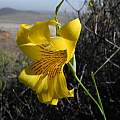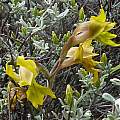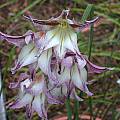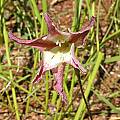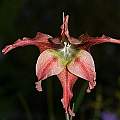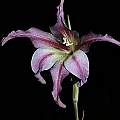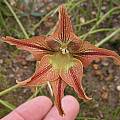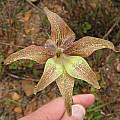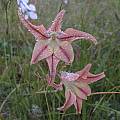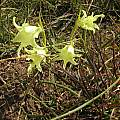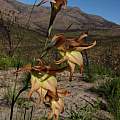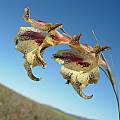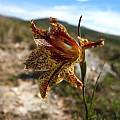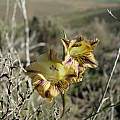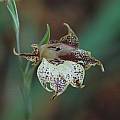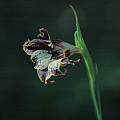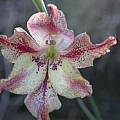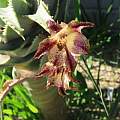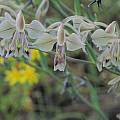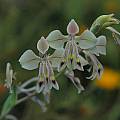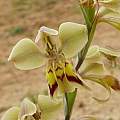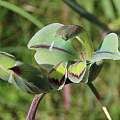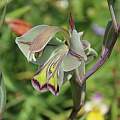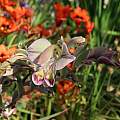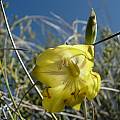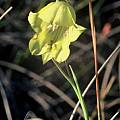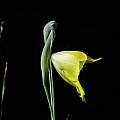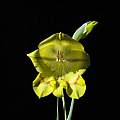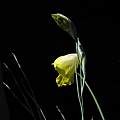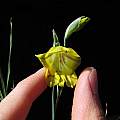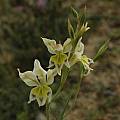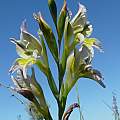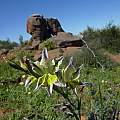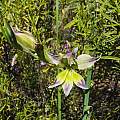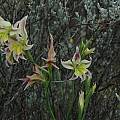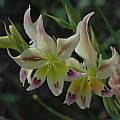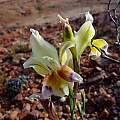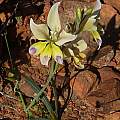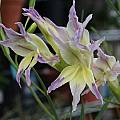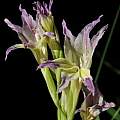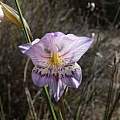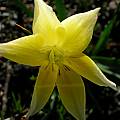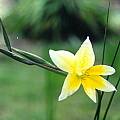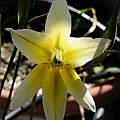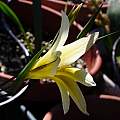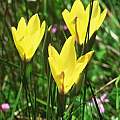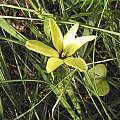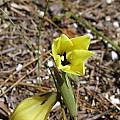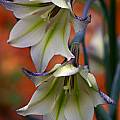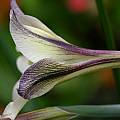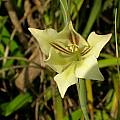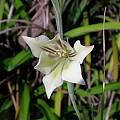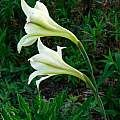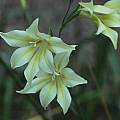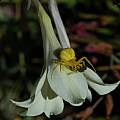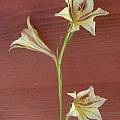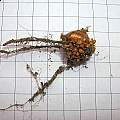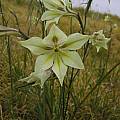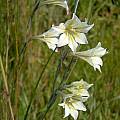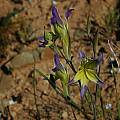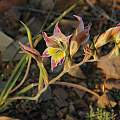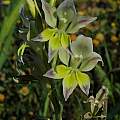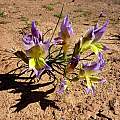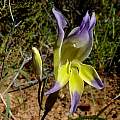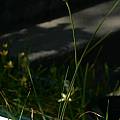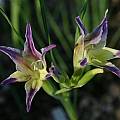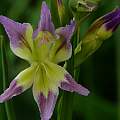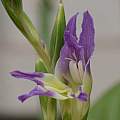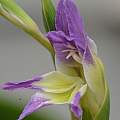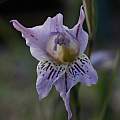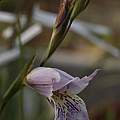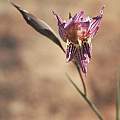Winter rain Gladiolus like their winters wet and mild and may need a dry summer dormancy. They are often less hardy, reaching down to USDA zone 8 at most.
Gladiolus abbreviatus Andrews (syn. Homoglossum abbreviatum) is an odd species with grossly unequal dark red to brown tepals. Height is 30-65 cm. It is pollinated by sunbirds and occurs in the southwestern Cape where it is found in clay and shale banks in renosterveld. Although in the book above it is described as usually having 4 to 6 flowers my plants grown from seed only have a couple and ones seen in the wild also did not have very many flowers. The first photo was taken by Mary Sue Ittner of seed grown plants and the last three in habitat by Cameron McMaster near Napier in the Overberg.
Gladiolus acuminatus F.Bolus is an endangered species known from no more than five locations. It is endemic to the Overberg where it grows in stony shale on flats and in renosterveld. It has a long perianth tube and pale greenish cream fragrant flowers. Height: 25-50 cm. Photo by Alan Horstmann.
Gladiolus alatus L. is a winter rainfall species found on flats, slopes, and plateaus, mainly in sand. The flowers are orange, marked yellow and have a light and pleasant scent. Height is 8-25 cm high. Photo 1 was taken near Paarl September 2003 by Bob Rutemoeller. The next two pictures were taken by Bob Rutemoeller and Mary Sue Ittner near Bainskloof September 2006.
Photos below are a white form of this species. The first photo was taken by Alan Horstmann. The next two photos from Mary Sue Ittner and Bob Rutemoeller were taken near Villiersdorp. The last photo by Bob Rutemoeller shows a white form for sale in a nursery in Caledon.
The photos below are of plants in cultivation. Photo 1 by Mary Sue Ittner shows flowers on a plant grown from seed blooming March 2005. Photo 3 from Bob Werra. Photos 3-6 were taken by Nhu Nguyen. Photo 5 show seeds on a 1 cm square grid.
Gladiolus angustus L. is found in wet places on sandstone soils in the southwestern corner of the southern African winter-rainfall region. Growing from 60 to 120 cm high, it flowers in spring (October and November) with cream to pale yellow flowers with diamond spade shaped yellow markings outlined in dark red on the lower tepals. The species has a very long perianth tube, usually 7 to 10 cm, and the lower tepals are substantially shorter than the upper tepals. It is related to Gladiolus carneus and Gladiolus undulatus. The first two photos from Mary Sue Ittner. The next two photos from iNaturalist taken by Chris Vynbos and shared under a CC BY-SA license. The last photo from Rachel Saunders.
Gladiolus aquamontanus Goldblatt is a local endemic found on streams and wet cliffs in the Swartberg Mountains in the Western Cape. A winter rainfall plant, it grows from 40 to 100 cm, but mostly hangs down where it grows and has sword-shaped grey green evergreen leaves with lightly thickened margins and midribs. The mauve pink flowers are in a 4 to 8 flowered spike. The lower three tepals have a dark purple median streak in the lower two thirds. Flowers are unscented and bloom time is late spring to summer. One of the pbs list members who grows it has found that it never wants to be completely dry. The first photo from Rod Saunders. The next photo from the book Plants of the Klein Karoo courtesy of Jan and Anne Lise Schutte-Vlok.
Gladiolus arcuatus Klatt grows in the dry western part of the winter rainfall area of South Africa. In Namaqualand this species grows among low shrubs in granite derived gravel and in fine grained silt in areas to the south. It has flowers that are dull grey purple, brownish or dark purple, with the lower three tepals yellow in the lower two thirds with the distal third dark purple fading to light grey purple. The dorsal tepal is largest, horizontal and arching forward. Flowers are very fragrant and probably pollinated by long tongued bees. Height: 12-20 cm high. The first photo below could be this species. It was seen in early September 2006 in Namaqualand in the right habitat. The second photo taken earlier that year was taken at Rod and Rachel Saunders' property at Brackenfell. They often sprinkle seed about. I think it also could be this species. Photos 1-2 taken by Mary Sue Ittner. Photo #3 taken by Rod Saunders.
Gladiolus aureus Baker is endangered. It is found in the wild today in only a single location, a peaty seep on a rocky sandstone slope in the Southwest Cape. There are reportedly as few as ten plants remaining at this location. It has bright yellow flowers. Height: 30-50 cm. The first photo was taken by Rachel Saunders August 2012 at its only known locality. There were five flowering plants surrounded by alien vegetation, houses and destruction. Photos 2-4 were taken by Bob Werra and the last photo by Michael Mace.
Additional information and photos from Ernie DeMarie: I grew three plants from seed that was refrigerated for well over a decade that came from the annual seed distribution of the Botanical Society of South Africa, which unfortunately they no longer do for international members. This species is not self compatible so when all three plants bloomed I was able to cross them and set a good amount of seeds. I distributed seeds or young corms to growers in California, South Africa, Australia, and Argentina in the hopes that this species could be maintained in cultivation as it is gravely endangered at its one locality on the Cape Peninsula.
Gladious aureus is not especially difficult to grow under my conditions but corms can exhaust themselves if they set a lot of seed. It will usually flower the third year from seed. It appears to reproduce mainly by seed; thus far I have not seen evidence of abundant cormlet production as happens with most other gladiolus species. It blooms in February for me. Being a small plant it can be managed under lights more easily than many other gladioli species.
Gladiolus blommesteinii L.Bolus is found on sandstone slopes in fynbos in the southwest Cape. It blooms August to October and grows from 30 to 60 cm high. Flowers are in a one to four flowered inclined spike, mauve or pink with dark longitudinal streaks on the lower tepals. Photo taken in habitat by Rachel Saunders.
Gladiolus brevifolius Jacq. blooms in fall before producing leaves and has small pink, gray or brownish flowers with yellow markings on the lower tepals. Plants grow 20-50 cm tall. It is found on sandstone and shale slopes in the north and south western Cape, South Africa. The first two photos of garden grown plants by Mary Sue Ittner and Bob Rutemoeller. The third photo was taken by Rod Saunders. The last picture was taken near Napier in the Overberg by Cameron McMaster.
Gladiolus brevitubus G.J.Lewis grows on rocky sandstone slopes in the Southwestern Cape and flowers in spring. Plants grow from 12 to 35 cm high. Flowers are unusual, resembling a Tritonia, orange with yellow markings at the base of the lower tepals. Leaves are linear with lightly thickened margins and midribs. The photo was taken December 2013 by Rachel Saunders on steep slopes in the mountains near Hermanus.
Gladiolus buckerveldii (L.Bolus) Goldblatt is a species restricted to a few sites along permanent rivers in the northern Cederberg of the western Cape. Plants grow out of nearly vertical moss covered cliffs. Growing from 80 to 125 cm, it has a horizontal spike of 12 to 20 ivory to greenish cream flowers, each with a spade or heart shaped dark red mark in the center of the lower tepals. It flowers in summer. In the past it was included in Antholyza as Antholyza buckerveldii because of its elongate floral tube (wide and cylindric above and slender below) and then was moved to Petamenes. In 1971 it was included in Gladiolus. Photos taken January 2014 by Rachel Saunders. It was growing on a cliff next to a waterfall.
Gladiolus bullatus Thunb. ex G.J.Lewis is found on sandstone slopes in fynbos in the southwest Cape and the Agulhas plain. This species is reported to be difficult in cultivation. It has bell-like blue flowers with yellow markings and is hooded. Height: 50-80 cm. The first photo by Bob Rutemoeller was taken at Boskloof, the second and third by Cameron McMaster in the Overberg, and the last a close-up from Alan Horstmann.
Gladiolus caeruleus Goldblatt & J.C.Manning (syn. Gladiolus gracilis var. latifolia G.J.Lewis) is found on limestone outcrops and calcareous sands close to the coast in the Southwest Cape. The flowers are pale blue with dark speckles on the lower tepals. Plant height: 40-60 cm tall. It blooms in winter. Flower photos by Bob Rutemoeller, Mary Sue Ittner and Bob Werra. Corms from Telos Rare Bulbs by M. Gastil-Buhl on a 1 mm grid.
The photos below were taken by Nhu Nguyen of plants bought from Telos Rare Bulbs. The last photo shows a blue triad of this species with Moraea aristata and Tecophilaea cyanocrocus.
Gladiolus cardinalis Curtis grows on wet cliffs and waterfalls in the southwestern Cape area of South Africa where the corms are wedged into cracks in the rocks where they are protected. Corms and roots must be constantly wet. This species flowers in the driest time of the year in midsummer (mid December to mid January), and is pollinated by the mountain pride butterfly. It is often found growing together with Disa uniflora, an orchid pollinated by the same butterfly. Growing from 55 to 90 cm tall, it has bright red flowers with white spear-shaped marks. This very beautiful species was one of the parents of modern day hybrids. The first photo was taken by Rod Saunders. The second photo from Rachel Saunders was taken January 2013 where it grows in a waterfall that plunges down the side of the mountain off a cliff that is probably 500 m high.
Gladiolus carinatus Aiton is found on sandstone slopes or deep coastal sands in many areas of the Cape. It flowers late winter to spring and can be blue to violet or yellow, rarely pink, often with yellow markings on the lower tepals. Height range: 30-60 cm high. The first two photos were taken by Mary Sue Ittner; the first photo was taken September 2001 in the Southwest Cape and the second shows the flower of a plant grown from seed and flowering March 2004. The next two were taken by Bob Werra. The last photo from Cameron McMaster shows a yellow form grown from seed by Rhoda McMaster.
The first five photos were taken in the Western Cape in Hopefield, Elands Bay, and near Napier by Cameron McMaster. The last photo is from Rod Saunders.
The photos from Alan Horstmann show different forms.
Gladiolus carmineus C.H.Wright is a narrow endemic of the southwestern Cape coast (winter rainfall) where it grows on rocky sandstone cliffs within the sight of the sea. Flowers appear in the fall (mid February to April) and are pale to deep pink. Each of the lower three tepals and sometimes the upper lateral tepals have a median whitish streak surrounded by a pale mauve halo. There are three to five reduced leaves on the flowering stem. Foliage leaves produced by plants that did not flower appear later and are long and trailing, 8 to 10 mm wide, glaucous with a lightly thickened midrib. Height range: 30-50 cm. They grow during the wet winter and spring, drying off in late spring.
Some PBS members report that they get better results from this bulb in pots if watering is started in late summer (August in California). Others report that it blooms reliably in dry ground even if given no supplemental water. You may need to experiment to see what works best in your climate. It is definitely easier to grow in coastal climates. It has naturalized in the coastal Northern California garden of Bob Rutemoeller and Mary Sue Ittner. They scatter seeds about after the pods split open. The first four photos were taken in this garden. The third shows the long narrow foliage leaves of a clump in February 2014. The fourth is a closer view of a leaf. Mary Sue was asked why these leaves look different from the ones in Nhu's photo below. She did a tour of her garden and found leaves of different widths, some curled, some upright, and some flat. So it may depend on how and where the plants are growing, as well as how old they are. Photo 5 was taken in September, 2005 by David Victor, which flowers in the UK during September, followed later by the foliage. Flower stems and foliage are grey-green. David's plants hold typically four or five flowers on a spike. The last photo is from the summer hemisphere and was taken by Bill Dijk.
Photo 1 is of a slightly lighter-colored form grown by Michael Mace. Photos 2-3 were taken by Nhu Nguyen. Photo 3 shows the pendent habit of the leaves, which makes sense since it grows on cliffs.
Photos taken in habitat near Hermanus, South Africa by Cameron McMaster.
Gladiolus carneus F.Delaroche (syn. G. blandus Aiton ) has a wide distribution in the winter rainfall area of southern Africa and is found in a variety of habitats. It is a variable species that grows to about 50 cm with white to pink large flowers usually with dark spade shaped markings on the three lower lobes. It flowers late spring. This one seeds set very easily and also increases by cormlets. Photos taken in the wild, the first by Cameron McMaster in the Overberg and photos two and three by Andrew Harvie in Table Mountain National Park. Photo four is from the book Plants of the Klein Karoo courtesy of Jan and Anne Lise Schutte-Vlok. The last two photos are close-ups taken by Alan Horstmann.
The first photo was taken by Doug Westfall. The second one was taken June 2003 in Northern California of plants grown from seed, photo by Mary Sue Ittner. The third photo was taken by Jana Ulmer of plants grown from the same seed batch as the picture above. In 2004 both her population and Mary Sue's produced a lot of flowers that bloomed a very long time. Another form has been a reliable bloomer in our Northern California garden where it is planted in the ground and returns each year. Photo four by Bob Rutemoeller. Fifth photo is of an unmarked form, by Gordon Summerfield. Photo of seed on a 10 mm grid by David Pilling
Gladiolus caryophyllaceus (Burm.f.) Poir. grows on sandstone flats and slopes in the winter rainfall area, flowers winter to spring, and has large pink to mauve flowers that are speckled on the lower tepals and fragrant. Height range: 25-110 cm. This species has naturalized in Western Australia. The first four photos by Mary Sue Ittner, Bob Werra, and Alan Horstmann.
The first four habitat shots from Alan Horstmann were taken in the Western Cape. The last two habitat shots by Andrew Harvie were taken east of Koebeeberge in the Western Cape.
Gladiolus ceresianus L.Bolus grows on stony slopes and flats in clay soil from southern Namaqualand to the western Karoo and in the Roggeveld and Bokkeveld Plateau. It is a small plant, up to 10 cm tall with linear leaves with four longitudinal grooves and one to four flowers in a inclined spike that are brown to purple with dark veining. Flowers are pleasantly scented. This species flowers from August to October in the wild. Flowers are similar to Gladiolus uysiae, but that species has flat leaves. It is also very similar to Gladiolus virescens, but has dark, hard scales around the corms. Photo 1 from Cameron McMaster taken on the Matjiesfontein Sutherland road in the Roggeveld, photo 2 from Alan Horstmann, and photo 3 from Rod Saunders. The last two photos from the book Plants of the Klein Karoo courtesy of Jan and Anne Lise Schutte-Vlok.
Gladiolus comptonii G.J.Lewis is a rare plant that grows on rocky sandstone slopes in the northwest Cape in a localized area on Heerenlogement Mountain at the northwestern end of the Olifants River Mountains. Plants grow 45 to 60 cm high. The leaves are linear and the few bright yellow short tubed flowers have brown streaks on the lower tepals. This species flowers mid to late July (winter). Photo taken by Rachel Saunders.
Gladiolus crispulatus L. Bolus is a rare endemic that is found in the Southwestern Cape on south facing slopes between Swellendam and Riversdale. Growing to 30-40 cm, it has four or five superposed leaves, with the midribs lightly thickened and usually paired on one side and single on the other, and deep pink flowers with triangular median streaks and dark spots in the throat. It is similar to Gladiolus oreocharis but has larger flowers and different leaves and to Gladiolus carneus which also has different leaves and tepal markings. If flowers November-December, but usually only in the first several years after a fire so is rarely seen. The first photograph from Rachel Saunders was taken close to the top of the Langeberg Mountains. The next photos from iNaturalist were taken by Brian du Preez in November in the Western Cape and lennartn in November near Swellendam and shared under CC BY-SA and CC BY-NC licenses.
Gladiolus cunonius (Linnaeus) Gaertner (syns. Anomalesia cunonia, Antholyza cunonia) has bright red flowers and blooms in the spring and grows in sandy soils near the coast. Plants grow from 20-70 cm high. The first three photos were taken by Bob Rutemoeller and Mary Sue Ittner and the next three by Cameron McMaster in habitat near Agulhas and Arniston in the Overberg. The last picture shows the seed capsules hanging over the cliff near the ocean.
Gladiolus cylindraceus G.J.Lewis grows on rocky sandstone slopes and ridges in low fynbos vegetation at elevations above 1500 m in the Ceres District of the Southwest Cape. Growing to 50 cm, it has three distinctive linear leaves with the lower one or two basal and the lowermost reaching to between the base and apex of the spike, sheathing the stem and cross shaped in transverse with wide grooves. The unscented flowers are pale pink to salmon with a diamond shaped red mark sometimes with a white to yellow center on the lower tepals. The tube is slender and elongate, up to 52 mm long. It flowers December to January. Photos from Rod Saunders and Rachel Saunders. The first was taken on the Waboomsberg Mountain and the others in the Witsenberg Mountains where there were flowers in colors from pink to apricot to almost yellow.
Gladiolus debilis Ker Gawler is found on rocky sandstone slopes in the southwest Cape, blooming in spring with white to pale pink flowers with red markings on the lower tepals. Height range: 25-45 cm. The first photo by Mary Sue Ittner was taken in September 2001 in an area in the southwest Cape that had burned the year previously and the second was taken by Bob Rutemoeller September 2003 at Boskloof. The third was taken by Ragnhild Crawford. Photos four and five taken near Napier in the Overberg by Cameron McMaster. The sixth photo was taken by Andrew Harvie at Silvermine in Table Mountain National Park. Last photo by Christopher Whitehouse taken at the Phillpskop Mountain Reserve near Stanford.
Gladiolus deserticola Goldblatt is restricted to the Richtersveld, a mountainous area of northern Namaqualand. Plants grow in sheltered sites, most frequently in clay soils on south-facing slopes protected by rock or shrubs. Flowers are dark blue with a darker line in the midline of the tepals. The lower tepals or the lateral lower tepals are cream edged with purple. Flowers are weakly rose scented. Height: 10-20 cm. Photo from Rachel Saunders who found a single specimen blooming in July 2011, a bit early for this species that usually blooms mid August to mid September.
Gladiolus dolichosiphon Goldblatt & J.C-Manning was first described in 2009, after a first collection from 1986 wasn't correctly identified as new species. It grows on seasonally wet places on cool south-facing slopes in altitudes above 1300 m in the western little Karoo. The flower spike holding 4 to 7 seven pink to creamy salmon unscented flowers with the lower three tepals each with a pale lozenge-shaped median mark outlined in dark red may have up to two lateral branches. It is a member of the long tubed pink flowered Gladiolus carneus complex but is distinguished from that group by its 5 or 6 linear leaves, creamy pink to salmon flowers with a tube 30-50 mm long and longer than the dorsal tepal, and its late summer flowering (late January to mid February). Height range: up to 40 cm. The first photo from Rachel Saunders was taken the second year after a fire, January 2017. The second photo from the book Plants of the Klein Karoo courtesy of Jan and Anne Lise Schutte-Vlok.
Gladiolus engysiphon G.J.Lewis is found in clay and granitic loam in renosterveld and grassland in the Langeberg Center (Swellendam to Mossel Bay). Growing from 35 to 50 cm high, it flowers March to April. The cream flowers with red median streaks are arranged in a 2 to 6 flowered spike. Photos taken by Rogan Roth in the southern Cape in April 2021. He first thought it was Gladiolus bilineatus which has a similar flower, distribution, and flowering time in the autumn. Both are pollinated by a species of long-proboscid fly. According to John Manning the lowest leaf in Gladiolus bilineatus always develops a short, sword-shaped blade, whereas the leaf blades in Gladiolus engysiphon are either absent entirely or needle-like. The arrangement of the leaves and the diameter of the stem is also different in the two species.
Gladiolus equitans Thunberg is very similar to Gladiolus alatus but has short, broad leathery leaves with raised margins and grows on rocky hills in Namaqualand. The first one was photographed in Namaqualand in August 2001 just after it rained by Mary Sue Ittner. The second photo was taken in about the same place in September 2006 by Bob Rutemoeller, but the plants were already in seed this time. The third picture was taken by Rod Saunders. The fourth and fifth photos were taken in habitat in the Kamiesberg by Andrew Harvie.
Photos below were taken by Alan Horstmann.
Gladiolus exilis G.J.Lewis is a fall-blooming, winter-growing species from the mountains of the Western Cape where it grows in clay loam in fynbos. Growing from 25-45 cm tall, it has white to pale blue fragrant flowers with dark streaks on the lower tepals. It looks similar to Gladiolus gracilis. Photos from iNaturalist taken by Peter Thompson in the Western Cape in May and shared under a CC BY-NC license.
Gladiolus floribundus Jacq. grows on dry clay, sandy or limestone flats and slopes over a broad area of the winter rainfall Cape. It has white to cream or pinkish flowers with a dark median streak on all of the tepals and blooms in late spring. Height range: 20-45 cm. The first two photos taken by Cameron McMaster near Napier in the Overberg. Photos three, four, and five were taken by Andrew Harvie. Photo three was also taken in the Overberg in the De Hoop Nature Reserve. The last two were taken on a a rocky ridge top in the Swartberg Mountains.
Photos below from the book Plants of the Klein Karoo courtesy of Jan and Anne Lise Schutte-Vlok who write that this species grows up to 60 cm tall with broad grey green leaves. It can be confused with Gladiolus grandiflorus which has a shorter tube.
Gladiolus fourcadei (L.Bolus) Goldblatt & M.P.de Vos, syn. Homoglossum fourcadei (L.Bolus) N.E.Br, syn. Antholyza fourcadei L.Bolus, grows in a variety of soils in the Uniondale district of the Southern Cape. It has small, greenish yellow flowers with reddish veins and spots. Height range: 40-60 cm. This species is endangered, and reportedly now grows in only a single location threatened by overgrazing. The first photo was taken by Rod Saunders and the next three by Mary Sue Ittner.
Gladiolus gracilis Jacq. is very similar to Gladiolus caeruleus, but is a bit smaller, has fewer flowers (2 to 5 in a spike), is usually blue to grey, but occasionally pink or yellowish and has dark streaks (instead of spots) on the lower tepals. The lowermost tepal is usually longer in this species instead of mostly the same length as the others in G. caeruleus. It is found mostly on clay slopes (or granite) and blooms in winter. Height range: 30-60 cm. The first two photos were taken by Alan Horstmann. The third was taken by Mary Sue Ittner March 2004 of flowers grown from Silverhill Seed and the fourth in 2007 of more seed grown plants, but this time one with pink flowers. The last photo was taken by Bob Werra
The photos below were taken by Nhu Nguyen of a plant from Telos Rare Bulbs.
All of the pictures below were taken by Cameron McMaster near Napier in the Overberg and illustrate the different forms possible.
The photos taken by M. Gastil-Buhl show seeds from Silverhill Seed dry on a 1 mm grid, then wet.
Gladiolus grandiflorus Andrews grows on clay slopes in the renosterveld in areas with winter rainfall and some year round rainfall. Growing from 25 to 50 cm, it has sword shaped leaves with thickened margins and midrib and cream to greenish flowers in a two to nine flowered spike, sometimes with a darker median streak on lower or all the tepals. If flowers September to October. Photos 1-3 by Mary Sue Ittner of plants grown from seed that had creamy white flowers marked in red and flowered late April, early May each year in her Northern California garden. Photo 4 taken by Bob Rutemoeller at Bontebok National Park September 2003. The last photo below from the book Plants of the Klein Karoo courtesy of Jan and Anne Lise Schutte-Vlok.
Gladiolus griseus Goldblatt & J.C.Manning grows in calcareous sand and limestone soils right near the sea, all up the southwest coast to Saldanha. The total wild population of this species is estimated to be less than 250 plants. There are 3 to usually 6 to 15 small mauve to grey flowers with a yellow band across the upper third of the lower tepals edged in green and maroon. The dorsal tepal arches over the stamens and the lower narrow tepals are directed forward. The flowers are lightly fragrant and bee pollinated. This species is closely related to Gladiolus carinatus and sometimes difficult to distinguish from it. Bloom time is different as this species blooms earlier in winter (May to July). The flowers are also smaller and unbranched with the upper tepals arched forward and there are usually more flowers on a spike. Height range: 30-60 cm. The first two photos from Arnold Trachtenberg. The last three photos taken June 2011 by Rachel Saunders on the southwest Coast shows the variation in different plants.
Gladiolus gueinzii Kunze grows on coastal sand dunes at and above the high tide mark in the southern Cape where it occurs in both the winter and the summer rainfall areas. It produces small cormlets around the base of the buried corm like other species, but also produces a large glossy dark corm that is bouyant in the water and is dispersed to new areas by floating. Growing from 25 to 50 cm high, this species has four to eight mauve flowers with red-purple and white markings on the lower tepals. It flowers in late spring to summer. The first photo was taken by Rachel Saunders. The second photo was taken on the Otter Trail by Andrew Harvie.
Photos from Paul Sieben who comments: "The first photo reflects how close to the sea they grow and flourish. The base of the dune would have been cut by the past equinox spring tides. The second shows how big the pods are and how full they are relative to the flower. All the flowers I have seen have been very similar to the one that Andrew Harvie took (above), they hardly open. The abundance of seed and plants could be due to the closure of our beaches (in 2020) and a lengthy lockdown period here in SA, far less trampling of the dune area as this is at a popular access point".
Photo 3 shows how offset bulbs form around the base of the stem and result in clusters of plants.
In September 2023 "We have had extreme storm surges associated with Spring equinox tides which has stripped the coast of sand exposing the bulbs. This shows the white stem indicating that the bulbs are between 200 and 300 mm below the surface. In my experiences this is very deep for gladioli bulbs, it is possibly to prevent dehydration on the dunes. At least 70 % of the bulbs have been washed away in this one incident".
Gladiolus guthriei F.Bolus is a winter-growing species that occurs on rocky sandstone outcrops in the Western Cape. It incorporates plants formerly known as Gladiolus odoratus L.Bolus. It blooms in fall to early winter; April to June in its native range. Plants that will bloom send up a flowering stalk with very short leaf stubs on it. Plants not blooming in that year produce a long leathery leaf. The flowers generally have a pale yellow or straw base color, liberally decorated with mauve or dark magenta streaks and freckles. The result looks fairly dull from a distance, but the flowers reward close examination. They have a sweet scent. Height range: 40-70 cm. First four photos taken in Napier and Villiersdorp in the Overberg by Cameron McMaster. The fourth and fifth photos are of the Gladiolus odoratus form, blooming in December in California by Michael Mace.
Gladiolus hirsutus Jacq. has been described under many different names. For a long time it was confused with Gladiolus caryophyllaceus which has larger scented flowers and in the 1972 revision of this genus was named Gladiolus punctulatus but that name is no longer accepted as the correct name. It is widespread in the winter rainfall areas where it is found in a variety of habitats (sandy flats, mountain slopes, rocky outgroups), usually in sandstone or granite soils. It is pink to purple or white with darker streaking on the lower three tepals. The leaves are very hairy, hence the name. Height: 35-50 cm. The first two photos were taken by Bob Rutemoeller and Mary Sue Ittner in the southwestern Cape in September 2001 in an area that had burned the year before. The next two by Mary Sue Ittner were taken in August 2006 near the Du Toit Kloof mountain pass where we saw these blooming down the slope when we stopped to look at the view including a close-up of the latter when holding the flower helped to get the plant in focus because it was so windy. The fourth and fifth photos were taken in the Phillipskop Mountain Reserve near Stanford, by Christopher Whitehouse.
More habitat photos from Cameron McMaster from Hermanus and Napier in the Overberg.
Photos by Bob Werra, Mary Sue Ittner, and Alan Horstmann of garden plants.
Gladiolus huttonii (N.E.Br.) Goldblatt & M.P.de Vos syn Homoglossum huttonii N.E.Br is found on sandstone slopes in the southeastern Cape and flowers winter to spring. It has red to orange flowers with the lower tepals sometimes yellow. Height range: 30-60 cm. The first photo was taken by Bob Rutemoeller of a plant grown by Alan Horstmann. The next two pictures were taken by Mary Sue Ittner. Photos of many interesting hybrids of this species are found on the Gladiolus hybrids wiki page.
Gladiolus hyalinus Jacq. is a wide spread species in the winter-rainfall region where it is found from Namaqualand to the southwestern Cape and in a couple of places in the southern Cape and the Eastern Cape. In the Cape Flora region it is found in transitional fynbos and in Namaqualand on granite derived sand or clay. It flowers from winter into spring depending on the elevation. Flowers are light to reddish brown on a pale cream background. There are dark spots and streaks on the throat. Height range: 30-60 cm. The first five photos taken by Mary Sue Ittner who grew her plants from seed. Photos 4-5 were taken in a later year of flowers that look very different from the flowers of the one that bloomed in the past. The last photo was taken by Andrew Harvie on the R27, near Nieuwoudtville.
Gladiolus inflatus Thunb. grows in open habitats on sandstone, often in rocky outcrops or in stony ground among shrubs and restios in the mountains of the Western Cape. It has pink to mauve, purple or violet short tubed flowers. The lower tepals have dark spear or spade shaped purple to red marks in the middle third. The mark on the lower median tepal is usually yellow in the center. This species blooms in spring. Height range: 25-60 cm. Photo taken by Rod Saunders.
Gladiolus inflexus Goldblatt & J.C.Manning is endemic to only a few places in the Southwestern Cape where it grows in sandstone derived gravel. Growing from 20 to 35 cm, it has 1 to 3 purple flowers formed on a wiry bent stem. The sweetly scented flowers have a strongly arched dorsal tepal and a large lower median tepal that is greater than the lower laterals. The bases of the tepals and the throat are cream with the lower tepals speckled to blotched purple. Flowering time is mid to late July, sometimes into August. The first photo was taken by Rachel Saunders. The next three were taken by Alan Horstmann.
The next three photos from iNaturalist were taken by Douglas Euston-Brown in July near Worcester and shared under a CC BY-SA license.
Gladiolus insolens Goldblatt & J.C.Manning grows in a few wet sites along streams and seeps in rocky areas on the higher slopes of the Piketberg in the western Cape. It has a spike of one to three bright scarlet flowers and five to seven narrow grey green leaves. Height range: 30-50 cm. Photo by Rachel Saunders.
Gladiolus involutus D.Delaroche is found on clay slopes in renosterveld and grassland in areas with summer and winter rainfall. Flowering from winter into spring, it has white flowers with yellow-green markings on the lower tepals. Height: 30-50 cm. Photo by Bob Werra.
Gladiolus kamiesbergensis G.J.Lewis grows in rocky sites in shrubby fynbos in the Kamiesberg of central Namaqualand. From 45-90 cm tall, this species has small, pale, lilac flowers with minute purple dots within and on the reverse of the tepals. The lower lateral tepals are yellow on the lower half of the limbs. This species flowers in spring and the flowers are sweetly scented and probably pollinated by long-tongued bees. Photos taken by Andrew Harvie.
Gladiolus karooicus Goldblatt & J.C.Manning was named in 2009. It is found from the Little Karoo to the Komsberg section of the Roggeveld Escarpment. Photos taken September 2011 by Cameron McMaster near Matjiesfontein.
Gladiolus leptosiphon F. Bolus is an uncommon species from South Africa that occurs from Ladismith in the Little Karoo to Uitenhage in the Eastern Cape where it is found on stony hills and low mountain slopes in renosterveld or arid fynbos. It is threatened by ongoing habitat loss to agricultural expansion, particularly ostrich farming but also crop cultivation. Plants grow up to 60 cm tall with narrow whip like leaves and 6-9 creamy white flowers marked with dark red-purple lines on the lower three tepals and a long slender tube. The upper three tepals are largest, the dorsal suberect and the lower tepals narrow, channeled, arching downward. Flowering is in spring (October to November). Pollination is by a long-tongued fly. Photos from the book Plants of the Klein Karoo courtesy of Jan and Anne Lise Schutte-Vlok.
Gladiolus liliaceus Houtt. grows on clay slopes over a wide area of South Africa (from the Cedarberg Mountains to Port Elizabeth) and blooms winter to spring. Growing from 30 to 80 cm high, the 1 to 4, sometimes 6, flowers are an inclined spike. The large flowers are brown, dull pinkish red, tan, purplish or cream to greenish yellow and turn bluish to mauve in the evenings when they become intensely clove scented. Depending on the location and the elevation with the lower elevations blooming earlier, this species blooms from late August to December.
The ones grown by Mary Sue Ittner have not been very fragrant and the color change is subtle. Photo 1 was taken by Mary Sue Ittner. Photos 2-3 from Bob Rutemoeller attempt to show the change in color. Photo 2 was taken during the day and photo 3 in the early evening. Andrew Harvie's photos (4-5) show the orangey red color of the day and the more purple color of the night. To ensure correct color balance both photos were taken with a flash and same exposure. He notes that he wishes he could also share the fragrance.
The forms pictured below in the first four photos were all found at Drayton and were blooming August-September 2003. Photos by Bob Rutemoeller including a single yellow one. The fifth photo is of a red flowered one photographed by Cameron McMaster near Bredasdorp in the Overberg. The last photo from the book Plants of the Klein Karoo courtesy of Jan and Anne Lise Schutte-Vlok.
Gladiolus maculatus Sweet extends across the southern coast and immediate interior of the winter rainfall area to the Eastern Cape where it is often found growing in heavy soils in renosterveld. Flowers are dull yellow to lilac and speckled with brown or purplish spots. They are long-tubed and fragrant during the day and the evening. Height range: 30-60 cm. The first three pictures were taken by Cameron McMaster near Napier and Bredasdorp in the Overberg.
The first two pictures below are of garden flowers taken by Mary Sue Ittner December 2007 and January 2009. The next two were taken by Alan Horstmann and the last by Dirk Wallace.
Gladiolus marlothii G.J.Lewis is endemic to the Roggeveld Escarpment. It grows on open slopes or among rock outcrops, always in heavy clay and usually in rocky situations at an elevation of 1800 m. Flowers are pale blue-lilac with a transverse yellow band about the base of the limb and are densely speckled with dark purple at the edges of the yellow band. Height range: 45-60 cm. Photograph taken by Rod Saunders.
Gladiolus martleyi L.Bolus syn. Gladiolus pillansii grows on sandy and rocky flats in the northern and southwestern Cape and blooms in the fall on a flowering stalk without leaves. Growing from 30 to 60 cm, it has usually scented pale to pink or lilac flowers. The lower lateral tepals each have a transverse band or a spear shaped yellow mark edged darker pink or purple in the upper half. The first photo by Bob Rutemoeller shows one grown from IBSA seed from Betty's Bay. The second photo was taken by Dirk Wallace. Other photos taken by Christopher Whitehouse in the Phillipskop Mountain Reserve.
Gladiolus meliusculus (G.J.Lewis) Goldblatt & J.C.Manning, syn. Gladiolus alatus var. meliusculus is found on low hills and flats on the western Cape coastal plain where it grows in sandy sites formed from decomposed granite or sandstone that are waterlogged during the period of growth. Flowers are salmon, brick-red or orange with yellow markings on the lower tepals. Gladiolus meliusculus differs from Gladiolus alatus by having shorter stamens and the yellow on the lower tepals is less pronounced and edged by a band of red-purple and the upper halves are pink to orange. Height: 12-25 cm. The first three photos were taken by Mary Sue Ittner and Bob Rutemoeller September 2006 near Darling. The other two were taken near Brackenfell on Rod and Rachel Saunders' property where they are growing this species.
Gladiolus merianellus (L.) Thunb. is a species that has had many different names and settled for a while under Gladiolus bonaespei Goldblatt & M.P.de Vos (originally spelled bonaspei). Other synonyms are Homoglossum merianellum (Thunb.) Baker, Homoglossum merianellum (Thunb.) Baker var. aureum G.J.Lewis, and Petamenes pilosus (Klatt) Goldblatt. It has also been known as Watsonia pilosa Klatt. This species grows on sandy flats and slopes in the Southwest Cape. It has 2 to 7 orange, rarely yellow flowers. Flowers held up very well during a wet period in February when they bloomed and over the course of the blooming period the color changed slightly from all orange to orange with yellow tones. Height range: 30-50 cm. The first photo is from Rod Saunders. The next three photos are from Mary Sue Ittner and the following two are by Dylan Hannon of the first flowering of his seed-grown plants 10 years after sowing.
Gladiolus meridionalis G.J.Lewis is found in the Southern Cape from the Overberg to Port Elizabeth (both winter and summer rainfall areas) and flowers from June to August. The distribution is discontinuous. Plants grow in stony sandstone soils in low fynbos on mountain slopes and flats that are usually in sight of the ocean. The populations in the west of the range have dark pink to salmon flowers and those in the east have cream to pinkish orange flowers. Flowers are adapted for pollination by sunbirds with a long perianth tube. An article here describes a rare finding of this species. Height: 35-45 cm. The first photograph from Cameron McMaster was taken on the farm Fairfield in the Napier district where it occurs on sandstone slopes. The second photo was taken by Rachel Saunders.
Gladiolus miniatus Eckl. is found on coastal limestone outcrops from Hermanus to Agulhas. Spring blooming flowers are salmon with red along the midline. Height: 15-40 cm. The first photo was taken by Dirk Wallace and the second and third by Cameron McMaster at Arniston. The last two photos were taken by Mary Sue Ittner in May 2005 when they were blooming for the first time from seed in Northern California with California bulb companions Brodiaea jolonensis, Allium unifolium and Triteleia hyacinthina in bloom in the same raised bed.
Gladiolus monticola Goldblatt & J.C.Manning is found on rocky sandstone slopes in the southwestern Cape. There are populations on Table Mountain. It has pink to apricot flowers with darker pink markings on the lower tepals and blooms summer into fall before the single leaf is produced. Height: 30-45 cm. The first two photos by Bob Rutemoeller. This first photo shows it as the only bulb blooming in one of our raised beds that only has bulbs from winter rainfall areas, blooming in July 2003 in the northern hemisphere. The leaf in the picture is of another Gladiolus that bloomed a month earlier. In the second photo we put cardboard behind the flowers to get the close-up that shows the details better. The third photo was taken years later by Mary Sue Ittner. The last photo from Rachel Saunders was taken on Table Mountain February 2011.
Gladiolus mostertiae is found in wet sandy soils in the Bokkeveld Mountains in the Northwest Cape. Growing 25 to 30 cm high, this species has linear leaves with a thickened midrib and pale pink flowers with yellow-green markings on the lower tepals. It flowers November to December. Photo taken by Rachel Saunders November 2013 near Nieuwoudtville in a year with late rainfall so the soil was still wet when it bloomed.
Gladiolus mutabilis (Harms) Goldblatt is an Eastern Cape species and also occurs in the eastern part of the Western Cape. Plants grow in sandstone derived soils. This species has slightly fleshy leaf blades without thickened margins or midribs and an elongated corm that is two to three times as long as wide. Flower color ranges from pale to dark blue, mauve, brown or cream. The lower tepals are usually cream or yellow below with dark blue or brown dots and streaks on the yellow background forming the nectar guide. The fragrant flowers appear early in the season, June or July. Height: 25-50 cm. The first photo was taken by Rachel Saunders who discovered this plant late July 2012 blooming in an area that had previously burned in the Western Cape. The next two photos were taken by Cameron McMaster August 2012 at the top of Potjiesberg Pass south of Uniondale (Eastern Cape) where it was growing with Gladiolus patersoniae. In the Western Cape population Gladiolus patersoniae was also in flower raising the question of whether they are both pollinated by the same pollinator. The last photo from the book Plants of the Klein Karoo courtesy of Jan and Anne Lise Schutte-Vlok.
Gladiolus nerineoides (N.E.Br.) G.J.Lewis is found on rocky sandstone slopes and cliffs in the southwestern Cape, flowering January-March. Growing from 35 to 60 cm high and flowering before the leaves are produced, it has funnel shaped scarlet flowers crowded together. Photos from iNaturalist taken by Peter Thompson in February and shared under a CC BY-NC license.
Gladiolus orchidiflorus Andrews is found on clay and sandstone soils from Namibia to Cape Flats and also to Free State and flowers in the spring. It has linear to sword-shaped leaves that are thickened in the midline. Flowers are in a 5 to 12 flowered spike, windowed in profile, greenish to purple with dark purple markings on the lower tepals, and are very fragrant. Plant height: 30-40 cm. Photos 1-2 are habitat shots taken in Namaqualand by Bob Rutemoeller and Mary Sue Ittner September 2006. Photos 3-4 were taken near Carolusberg, Namaqualand by Cameron McMaster September 2011.
The photos below were taken by Alan Horstmann.
Gladiolus ornatus Klatt is found on marshy sandstone and granite slopes in the Southwestern Cape, South Africa. Growing from 40 to 60 cm high, it has linear leaves and pink unscented flowers in a funnel shaped tube in a one to three flowered spike. The lower tepals each have a spear to spade shaped white median streak edged in dark pink and the lower part of the throat is white streaked with dark pink. Flowering is from September to November. Photo by Rachel Saunders.
Gladiolus pappei Baker grows in marshes on sandstone slopes in the southwestern Cape. It flowers in spring. Height range: 20-35 cm. The first two photos show a plant that was grown from Silverhill seeds sown in September 2001 and first blooming in June 2003. Photos by Bob Rutemoeller and Mary Sue Ittner. The last photo was taken by Rachel Saunders.
Gladiolus patersoniae is widespread in the southern African winter rainfall areas. It occurs in exposed rocky habitats in the interior ranges of the Cape Floral region, but also near the coast at Cape Infanta and on stony alluvial flats near Worcester. It grows on soils derived from sandstone. Plants grow to 50 cm and have narrow cylindrical leaves. The bell like short tubed and sweetly scented (similar to apple and carnation) pale to deep blue, slate, grey or cream flowers are pollinated by long tongued bees. The lower three tepals have a transverse yellow band usually outlined in dark blue or purple. Flowering occurs in late winter to spring, earlier at lower elevations. The first five photos by Cameron McMaster. His last one was taken August 2012 at the top of Potjiesberg Pass south of Uniondale (Eastern Cape) where it was growing with Gladiolus mutabilis. The last photo from the book Plants of the Klein Karoo courtesy of Jan and Anne Lise Schutte-Vlok.
Gladiolus priorii (N.E.Br.) Goldblatt & M.P.de Vos (syn. Homoglossum priorii (N.E.Br.) N.E.Br.) is a fall blooming species (April to June) found on sandstone and granite slopes in the Southwestern Cape, South Africa. Growing from 30 to 40 cm high, it has leathery linear leaves and tubular red flowers with yellow throats in a one to four flowered spike. They droop slightly, making it hard to see the centers unless you crouch down. It is considered relatively easy to grow in captivity, although Mary Sue Ittner has found in her Northern California coastal garden that it is short lived and has to be started regularly from seed. The first photo from Bob Rutemoeller shows a plant growing in the ground, flowering in November. The second photo was taken by Mary Sue Ittner, the third by Alan Horstmann, the fourth by Michael Mace, and the last by Bill Dijk.
The first two photos were taken by Cameron McMaster. The last two photos were taken by Rachel Saunders. The first of these was taken June 2011 of this species blooming on Table Mountain in the southwestern Cape in an area that had previously burned and the second in Hermanus.
Gladiolus pritzelii Diels is found on rocky sandstone slopes in the northwest Cape. It has bell-like yellow flowers with red to brown transverse markings on the lower tepals. Height: 30-50 cm. The first photo was taken by Cameron McMaster on Ouberg Road in the Roggeveld and the second by Rod Saunders from Silverhill Seeds. The flowers have a mild scent of green apples.
The photos below are of plants in cultivation. Photo 1 was taken by Alan Horstmann, and photos 2-5 were taken by Nhu Nguyen.
Gladiolus pulcherrimus (G.J.Lewis) Goldblatt & J.C.Manning has very striking orange to salmon flowers that are similar to Gladiolus alatus but is distinguished by broad sword shaped leaves that lack prominent veins. It grows in the northwest Cape on sandstone slopes. Height range: 20-60 cm high. The first photo from Bob Rutemoeller is of a plant grown by Gordon Summerfield in South Africa, which was blooming September 2003. The next two photos by Alan Horstmann, and Rod Saunders.
Gladiolus quadrangularis (Burm.f.) Ker Gawl. (syn. Homoglossum quadrangulare) is found on rocky sandstone slopes in the Northwest Cape. It has 4 to 10 red to orange flowers and blooms late winter into spring. Height range: 50-90 cm tall. Photos 1-3 were taken by Mary Sue Ittner showing plants that bloomed in Northern California March 2004 and 2007.
The photos below were taken by Nhu Nguyen. The seeds are on a 1 cm grid.
Gladiolus quadrangulus (D.Delaroche) Barnard (syn. Ixia linearis, G. linearis, G. biflorus) is found in the southwestern Cape in sandy soil in seasonally wet, poorly drained and sometimes brackish habitat. Goldblatt & Manning report that it has been eliminated from most of its original range, and that "its long-term survival in the wild is unlikely." Fortunately, it is relatively easy to grow in cultivation, where it can be treated like a typical winter-growing Glad. It has pale pink, mauve or white flowers. The tepals have darker veins. It blooms late winter into spring. The shape of the flowers is reminiscent of an Ixia, and unlike most Gladiolus it does not produce nectar. Goldblatt & Manning speculate that it is adapted to pollination by pollen-eating insects. Height range: 14-35 cm high. First photo by Alan Horstmann. Second photo by Michael Mace of a plant whose name tag was lost, but which is almost certainly G. quadrangulus. The final photo was taken by Rachel Saunders who photographed it in the wild.
Gladiolus recurvus Linnaeus occurs in shale derived soils from Ceres to Bredasdorp and flowers from June to October depending on the elevation. The fragrant flowers are pale gray to cream, yellowish or pinkish with purple lines and dots on the lower tepals and sometimes spotted or lined in the midline on the upper tepals as well. Height: 25-35 cm. The first two photos were taken by Cameron McMaster in the Overberg. The other photos by Dirk Wallace show variation in the markings on flowers.
Gladiolus rhodanthus J.C. Manning & Goldblatt is distributed on rocky sandstone slopes at high elevations in the southwest Cape. Growing from 30 to 50 cm, it has hairy linear leaves and pink flowers with red markings on the lower tepals. Photo by Rachel Saunders taken with some effort since it was quite a climb (in light rain/mist) to get to it. It was growing at 1700 m in cracks in the cliffs.
Gladiolus rogersii Baker grows to 60 cm and has narrow leaves with a prominent midrib. Flowers are blue to purple with yellow or white transverse markings on the lower tepals. In the Kammanassie Mountains flowers can be cerise-pink. This is a widespread South African species found on sandstone and limestone slopes in winter and year round rainfall areas and mostly blooms in spring. There are variants that flower from autumn to early winter on the foothills of the mountains in the Little Karoo. The first two photos and information from the book Plants of the Klein Karoo courtesy of Jan and Anne Lise Schutte-Vlok. The third photo by Mary Sue Ittner was taken of a plant growing on a slope east of Swellendam. Most of the flowers had been eaten by an insect. Photos 4-6 were taken by Alan Horstmann.
Gladiolus roseovenosus Goldblatt & Manning is a rare winter rainfall species that grows in peaty sandstone soil on well drained slopes in the coastal foothills of the Outeniqua Mountains in the southern Cape. Plants grow 20 to 40 cm high and the long tubed creamy pink unscented flowers with red nectar guides are in a 2 to 4 flowered spike. Blooming time is summer into fall, between February and April. Photos taken by Rachel Saunders.
Gladiolus rudis Licht. ex Roem. & Schult. grows on sandstone slopes in fynbos in the southwestern Cape and blooms in spring. It has 2 to 5 cream to pale pink flowers on a spike. The lower tepals have spear-shaped markings and the perianth tube is funnel shaped. Height range: 20-50 cm. The first three photos taken by Cameron McMaster near Caledon and Fairfield in the Overberg and the last taken by Alan Horstmann.
Gladiolus saccatus (Klatt) Goldblatt & M.P.de Vos, formerly known as Anomalesia saccata or Antholyza saccata, extends from the western Cape of South Africa into Namibia. It is found in both summer and winter rainfall areas. It has bright red flowers and is pollinated by birds. This one was growing alongside the road in Namaqualand. Height range: 25-80 cm. Photo #1 taken August 2001 by Mary Sue Ittner. The second photo was taken by Rod Saunders.
Gladiolus salteri G.J.Lewis is a winter-grower found in a small area in Namaqualand where it grows in coarse, gritty decomposed granite, or in red, wind-blown sand, usually on the edges or in the middle of drainage lines. It has thin pink unequal tepals, with red and cream chevrons on the lower ones, and is believed to be pollinated by long-tongued bees. Height: 10-20 cm. Photos from iNaturalist were taken by Nick Helme in Namaqualand August 2024 and shared under a CC BY-SA license.
Gladiolus scullyi Baker is found on silty clay and granite slopes in the northern winter rainfall areas (Namaqualand and western Karoo). It is very similar to Gladiolus venustus but is less colorful with dull yellow to light brown flowers with darker yellow on the lower tepals and darker brown to purplish highlights. The dorsal tepal is also more horizontal, inclined over the stamens and the upper two lateral tepals curve outward in an arc. It is fragrant and windowed in profile. Height range: 15-40 cm. Photos 1-2 taken by Bob Rutemoeller September 2006 near Nieuwoudtville (photos 1-2). Photos 3-5 taken by Cameron McMaster in various locations near Nieuwoudtville September 2011.
Photos 1-2 taken by Bob Rutemoeller September 2006 in Namaqualand. Photos 3-4 were taken by Cameron McMaster September 2011 near Carolusberg in Namaqualand. The last two photos were taken taken by Bob Werra.
Gladiolus speciosus Thunb. is found in deep sandy soils in the Northwest and Southwest Cape. It is similar to Gladiolus alatus with 2 to 8 flowers in a spike, orange marked yellow to greenish and hooded over the stamens. One of the distinguishing characteristics is that it is colored yellow on the reverse. Height range: 12-20 cm. The first four photos taken in the western Cape near Darling September 2006 by Bob Rutemoeller and Mary Sue Ittner. The last photo was taken by Andrew Harvie near Bokbaai in the Western Cape.
Gladiolus splendens (Sweet) Herb., formerly known as Anomalesia splendens (Sweet) N.E.Br., is found in rocky clay, mostly near streams in the Roggeveld and the Calvinia district. The bright red flowers are formed in a strongly inclined spike. Height: 50-110 cm. Photos 1 and 2 were taken by Mary Sue Ittner near Middelpos September 2006; photo 3 was taken by Bob Rutemoeller in a garden in Calvinia. Photo 4 was taken by Alan Horstmann. Photo 5 was taken by Uluwehi Knecht. Photo 6 by Nhu Nguyen shows the seeds on a 1 cm square grid.
Gladiolus stefaniae Oberm. grows in the mountains of the southern Cape on rocky slopes in gullies that are wet. It grows up to 60 cm. This species flowers at the end of the dry hot summer after the weather has become cooler and it has started to rain. The flowering stem is produced before the leaf. The large flowers are red with a median white streak in the lower two-thirds of the lower three tepals and are pollinated by the mountain pride butterfly. The first photo from the book Plants of the Klein Karoo courtesy of Jan and Anne Lise Schutte-Vlok. The last two photos by Mary Sue Ittner are close-ups of the first flower (of two) blooming September-October 2008 in Northern California. It has continued to flower, but not increase. It usally flowers in California before our rainy season has started.
Gladiolus sufflavus (G.J.Lewis) Goldblatt & J.C.Manning is found on marshy sandstone soils in the Bokkeveld Mountains. Growing from 45 to 70 cm high, it has linear to terete leaves, cross-shaped in section, hairy stems, and pale yellow to greenish bell-shaped scented flowers with dark markings on lower tepals. It flowers August to September. Photo from Rachel Saunders.
Gladiolus taubertianus Schltr. is restricted to the eastern Cederberg and the northern edge of the Cold Bokkeveld in the winter rainfall zone of the Western Cape where plants grow in coarse, stony, sandstone derived ground in well drained sites in dry mountain fynbos. Flowers are pale mauve to slate blue and lightly streaked with purple and lightly sweetly scented. The lower tepals have transverse yellow markings edged with dark purple. Flowering time is August to September. Height: 18-25 cm. The first photo from Rachel Saunders taken in the Cederberg August 2012 and the second taken in the Northern Cape September 2015.
Gladiolus teretifolius Goldblatt & M.P.de Vos (syn. Homoglossum muirii) is a rare plant found in the southern Cape growing in heavy soils in renosterveld. It has scarlet flowers and blooms fall to winter. Height range: 40-70 cm. Photos taken by Cameron McMaster in the Overberg, Bredasdorp and Agulhas.
Gladiolus trichonemifolius Ker Gawl. is found on wet sandy flats in the winter rainfall areas. Height range: 10-25 cm. It flowers in late winter to early spring and is cream to yellow with brown lines on the lower tepals and a darker yellow center.
Photos below show the typical form. The first photo by Alan Horstmann, the second by Mary Sue Ittner, and the last two by Michael Mace.
This species now includes a form formerly known as Gladiolus citrinus Klatt, which has a cupped perianth and a dark purple blotch in the center. It's very different from the typical form. The first three photos from Rod Saunders and Bob Rutemoeller show the former Gladiolus citrinus.
Gladiolus tristis L. is one of the more widespread species in the winter rainfall regions. It is often found in dense colonies on damp flats, but can be found near sea level to high elevations. It is nicknamed the marsh Afrikaner and can be found in marshy areas, but also on banks above streams, in poorly drained seeps or on cool south-facing slopes. The time of bloom varies by populations. It produces a lot of little cormlets around the base of the corm and can spread to other pots if soil is reused. This species also spreads by seed, and has been known to naturalize in habitats it likes such as gardens and botanical gardens. It's not a thug, but be aware of what you're doing if you put it in the ground in a mediterranean climate. Plants grow to about 2 feet (~0.7m) tall with slender, spiraling leaves about the diameter of a chopstick. It is easily grown in a well-drained mix, full sun, and summer dry dormancy. Give it a dilute or slow release fertilizer high in phosphorous when in active growth.
Photos 1-2 were taken by Sheila Burrow, 3 by Doug Westfall, 4-5 by Alan Horstmann and 6 by Kathleen Sayce.
I grow two forms. One is light yellow and blooms March to April. It is only slightly fragrant at night. It is the first one pictured below. In the second photo there is a spider on the flowers, catching what seems to be a fly pollinator. The second form pictured below in photos 3-4 is a late blooming form, once known as Gladiolus tristis var. aestivalis, but not recognized as a variety by Goldblatt and Manning. These plants were grown from IBSA seed collected near Paarl where they grow in wet boggy areas that are shady. This form is very fragrant at dusk/night when the flowers are open wider as well. The last photo shows one corm on a 1 cm grid with all the cormlets showing how many new plants are possible from one corm. Photos by Mary Sue Ittner .
Habitat shots taken by Bob Rutemoeller September 2003 at Drayton and Cameron McMaster at Bredasdorp.
Gladiolus undulatus L. is a late spring summer flowering plant found on marshy sandstone slopes in the northwest and southwest Cape. It has whitish to cream flowers with pink diamonds on the lower tepals. Plant height: 45-150 cm. Although it is similar to Gladiolus carneus, it has a much longer tube with wavy tepals. Given the right conditions in some areas outside of South Africa this species has naturalized. The first three photos were taken by Mary Sue Ittner of flowers blooming various years in June in northern California. Photos 4-5 were taken in habitat by Andrew Harvie near Bainskloof. The last photo was taken by Rod Saunders.
Gladiolus uysiae L.Bolus ex G.J.Lewis is brownish purple with dark veining and fragrant. It flowers late winter to early spring and can be found on clay slopes in renosterveld. Height: 7-15 cm. Photos 1-4 were taken in habitat near Middelpos in the Roggeveld by Mary Sue Ittner, Bob Rutemoeller and Cameron McMaster.
The first three photos were taken by Alan Horstmann in 2023 near Middelpos. The fourth photo was taken by Cameron McMaster near Nieuwoudtville September 2011. The last photo taken by Bob Rutemoeller shows one grown by Gordon Summerfield in South Africa flowering September 2003.
Gladiolus venustus G.J.Lewis has flowers that are shades of purple to pink and sometimes dull yellow with yellow markings on the lower half of the lower tepals. It is widely distributed across the interior of the winter rainfall areas of southern Africa where it is found in dry habitats on clay and sandstone slopes. The primary pollinators are long tongued bees. It can be confused with Gladiolus scullyi and it has been included in that species at one time but it usually more colorful than that species which is usually greenish cream to yellow brown or beige and more highly scented. The dorsal tepal on Gladiolus scullyi is also more horizontal, inclined over the stamens and the upper two lateral tepals curve outward in an arc. But the distinctions are sometimes difficult to tell, especially in areas where they both grow. An example of this difficulty is shown in the third picture which I suppose could be either species. Height range: 12-35 cm. The first two photos by Mary Sue Ittner and Bob Rutemoeller were taken September 2006 in the Roggeveld. The third photo from Mary Sue Ittner was taken near Nieuwoudtville. The last two photos were taken by Cameron McMaster September 2011 near Middelpos in the Roggeveld.
Photos below were taken by Bob Werra.
Photos below were taken by Arnold Trachtenberg.
Gladiolus violaceolineatus G.J.Lewis grows in the Cedarberg Mountains, where it is generally found on south-facing sandstone slopes that remain moist throughout the winter, according to Goldblatt & Manning. The flower is pale violet with dark purple lines on the tepals, which are often narrower and longer than shown in these photos. The flowers are sweet-smelling, and reportedly bloom in early spring, although they may bloom a bit later at higher elevations. Height range: 35-60 cm. The first two photos by Michael Mace. The last photo from Rod Saunders.
Gladiolus virgatus Goldblatt & Manning is restricted to cool, well watered slopes of the coastal ranges of the southwestern Cape. Poorly collected, it has been found in clay soil on ground covered with scattered sandstone boulders. Growing from 30 to 60 cm high, it has linear leaves with slightly thickened margins and midribs. The pale to deep pink or nearly white large unscented flowers are marked on the lower tepals with a spear shaped whitish median streak edged with a reddish v shaped mark, speckled in the throat and are in a two to four flowered inclined spike. The dorsal tepal is inclined over the stamens. This species flowers September-November. The first two photos from Rachel Saunders taken in the Helderberg Nature Reserve. The next three photos from iNaturalist taken by linkie in the same place in November and shared under a CC BY-NC license.




















































































































